Recent Storm Damage Posts
Ice Dam Water Damage Repair in Killingworth, CT
1/25/2022 (Permalink)
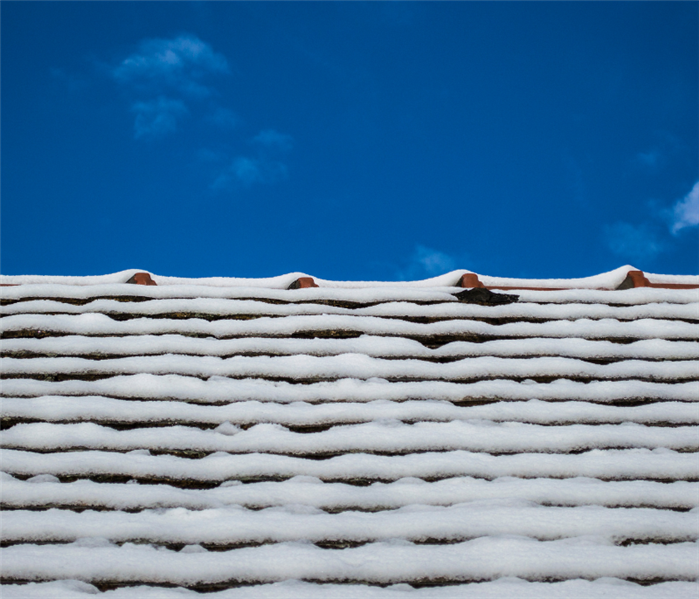 When ice dams cause snow and ice to leak in to your home, immediate action is needed to prevent water damage and mold growth.
When ice dams cause snow and ice to leak in to your home, immediate action is needed to prevent water damage and mold growth.
A roof or ceiling leak from an ice dam in Killingworth can cause considerable damage to your home. Water damage can spread throughout your property and even cause mold growth.
When you need immediate ice dam water damage repair in Killingworth, CT, the team at SERVPRO of Old Saybrook is always ready to respond!
Call Our Office For Immediate Assistance - 860-388-1776
Expert Services For Ice Dam Water Damage in Killingworth, CT
Complete Drying & Dehumidification
Advanced Moisture Detection Equipment
FREE Estimates
The damage from an ice dam roof leak in Killingworth requires immediate attention. The longer water damage goes unaddressed, the more likely it is to cause extensive issues to walls, floors, or ceilings and cause the growth of mold.
As your local water damage restoration service with over 15 years of experience, SERVPRO of Old Saybrook has the training and resources to provide immediate, expert restoration services. From initial inspection to the final repair - We're Here to Help.
SERVPRO of Old Saybrook also simplifies the insurance process. We directly communicate with your insurance company and submit all required documentation when you need ice dam water damage repair near Killingworth or the surrounding towns.
Our goal is to quickly address ice dam water damage in Killingworth, CT, making it "Like it never even happened."
Ice Dam Water Damage Restoration Process
One of our Project Managers will inspect the ceiling leak from the ice dam and create a plan for cleanup and restoration. A proper inspection is essential to return your home or business to pre-damage conditions.
An ice dam roof leak in Killingworth can cause saturated carpets or even standing water inside of your home. Our team uses commercial grade equipment to remove excess water and stop it from spreading to unaffected areas of your property.
Using advanced moisture detection and commercial grade drying equipment, SERVPRO of Old Saybrook will completely dry out all affected flooring, insulation, walls and ceilings as needed. This may include some amount of demolition to ensure that all affected areas are completely dried.
Ice dam water damage in Killingworth, CT requires proper cleaning and sanitizing to remove any dirt, bacteria, or lingering mold spores. When an ice dam causes mold, our team of mold remediation specialists in Killingworth can help.
Once the water mitigation process has been completed, there's still the matter of bringing your home back to normal, pre-damage conditions. Our in-house construction team can seamlessly take over to repair and replace building materials as needed - Just let our team know you're interested in repairs.
Ice Dam Damage: Common Questions
How do ice dams cause water damage?
Ice dams form when there's snow on your roof and your attic is warm enough to cause it to melt.
Melting snow and ice flow down the roof, but refreeze at the edge of the roof. This is because this area isn't warmed by your attic.
As this process repeats, melting snow can't drain off the roof and continuously builds up at the edge. This is what leads to ice dams. Over time, the trapped water under the ice dam backs up underneath roof shingles, through the roof, and causes snow and ice to leak into your home.
Is ice dam water damage repair in Killingworth, CT covered by insurance?
Yes, luckily in most cases homeowners insurance will cover the damages from an ice dam roof leak. However, they do not cover the cost of ice dam removal services.
How can you prevent ice dams?
Preventing the formation of ice dams is essential to avoid snow leaks every winter.
- Install better insulation in your attic to limit heat loss from living spaces
- Increase attic ventilation to keep the roof cool
- Use a roof rake to remove heavy snow from your roof before it can melt
- Make sure that no exhaust vents let out into the attic
Ceiling Leak From Ice Dam Causing Water Damage? Call Now - 860-388-1776
Ice Dam Water Damage Repair in Centerbrook, CT
12/14/2021 (Permalink)
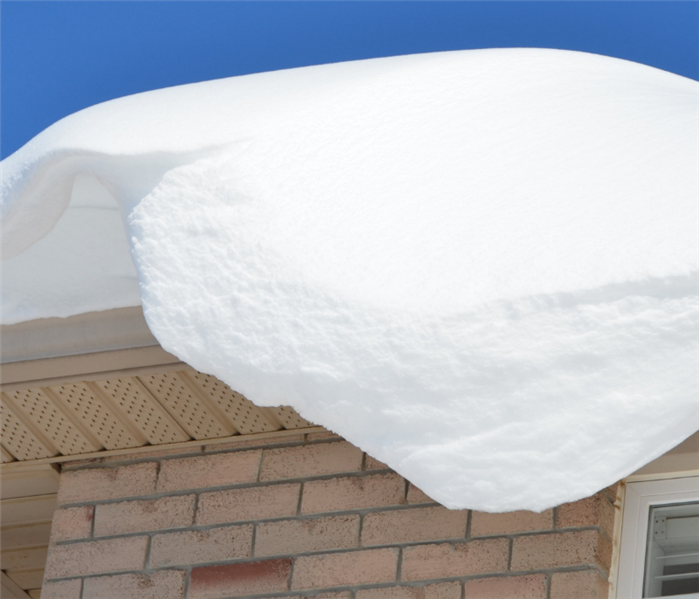 When ice dams cause roof leaks, water damage, and mold in Centerbrook, our team is Here to Help.
When ice dams cause roof leaks, water damage, and mold in Centerbrook, our team is Here to Help.
Roof and ceiling leaks from ice dams in Centerbrook are more common than many homeowners think. When it does occur, snow and ice leaking into your home can cause extensive water damage and mold growth.
If your home is affected by an ice dam roof leak, SERVPRO of Old Saybrook is always ready to provide expert services for ice dam water damage in Centerbrook, CT.
Call Our Office For Immediate Assistance - 860-388-1776
Ice Dam Water Damage Repair Services in Centerbrook, CT
Complete Drying & Dehumidification
Advanced Moisture Detection Equipment
FREE Estimates
The damage from snow and ice leaking into your home requires immediate attention. Without fast action, water damage can spread throughout your home, cause mold growth, and even cause structural issues.
As your local water restoration company, you can trust SERVPRO of Old Saybrook to provide professional ice dam water damage repair in Centerbrook, CT.
Our team has over 15 years of experience, equipped with all the training and resources required to quickly address water damage and mold.
SERVPRO of Old Saybrook also handles the insurance process for you, directly submitting all paperwork, estimates, photos, and more to your insurance company.
When you call SERVPRO of Old Saybrook for damage caused by an ice dam in Centerbrook, our team works hard to make it "Like it never even happened."
Ice Dam Water Damage Restoration Process
SERVPRO of Old Saybrook creates a unique damage restoration plan for each new ice dam water damage in Centerbrook, CT, but the general process still remains the same.
A Project Manager will inspect the damages to your property and create a cleanup and restoration plan.
There may be standing water or saturated carpets due to your ceiling leak from an ice dam in Centerbrook. Our team uses commercial grade extractors to remove excess water and prevent it from damaging other areas of your home.
Using advanced moisture detection and commercial grade drying equipment, SERVPRO of Old Saybrook will completely dry out all affected flooring, insulation, walls and ceilings as needed.
This may include some amount of demolition to ensure that all affected areas are completely dried. Without this step, it's likely for mold and mildew to grow and spread in your property.
Your ice dam roof leak in Centerbrook, CT requires proper cleaning and sanitizing to remove any dirt, bacteria, or lingering mold spores. If the ice dam causes mold growth, our team of mold remediation specialists in Centerbrook can help.
Once the water mitigation process has been completed, there's still the matter of bringing your home back to normal, pre-damage conditions.
Our in-house construction team can seamlessly take over to repair and replace building materials as needed.
Ice Dam Damage: Common Questions
How do ice dams form and cause damage?
These form when your attic is warm, which increases the temperature of your roof and melts snow on the upper areas of the roof.
Melted snow runs down your warm roof, but refreezes at the edges. This refreezing occurs because the edges of the roof extend further than the structure of your home, and isn't warmed by the attic.
Over time, the melted water created a large ridge of ice on the edge of the roof. The pool of water that gets trapped underneath the ice backs up underneath shingles, penetrates the roof deck, and leaks into the attic. This is how you end up with a ceiling leak from the ice dam.
Is ice dam water damage repair in Centerbrook covered by insurance?
Yes, in most cases the cleanup and repairs will be covered by your homeowners insurance company. However, they usually do not cover the cost of dam removal, which can range from $700-1500.
How can you prevent ice dams from forming?
There's a few methods for preventing ice damming, such as:
- Installing better insulation in your attic to limit heat loss from living spaces
- Increase attic ventilation to keep the roof cool
- Use a roof rake to remove heavy snow from your roof before it can melt
- Make sure that no exhaust vents let out into the attic
Ice Dam Water Damage in Centerbrook, CT? Call Today - 860-388-1776
Ice Dam Water Damage Repair in Essex, CT
12/7/2021 (Permalink)
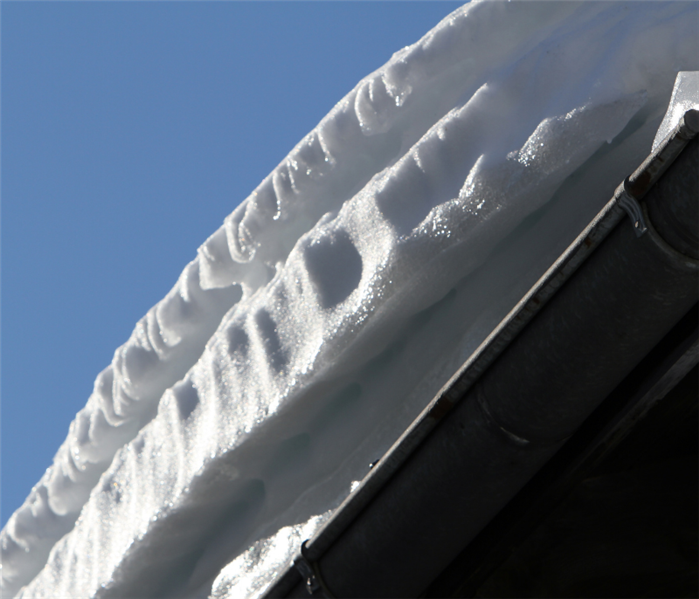 Dealing with roof and ceiling leaks from an ice dam in Essex, CT is something that should be left to a professional water damage restoration service.
Dealing with roof and ceiling leaks from an ice dam in Essex, CT is something that should be left to a professional water damage restoration service.
Roof and ceiling leaks from ice dams in Essex are more common than many homeowners think. When it does occur, snow and ice leaking into your home can cause extensive water damage and mold growth.
If your home is affected by an ice dam roof leak, SERVPRO of Old Saybrook is always ready to provide expert services for ice dam water damage in Essex, CT.
Call Our Office For Immediate Assistance - 860-388-1776
Ice Dam Water Damage Repair Services in Essex, CT
Complete Drying & Dehumidification
Advanced Moisture Detection Equipment
FREE Estimates
The damage from snow and ice leaking into your home requires immediate attention. Without fast action, water damage can spread throughout your home, cause mold growth, and even cause structural issues.
As your local water restoration company, you can trust SERVPRO of Old Saybrook to provide professional ice dam water damage repair in Essex, CT.
Our team has over 15 years of experience, equipped with all the training and resources required to quickly address water damage and mold.
SERVPRO of Old Saybrook also handles the insurance process for you, directly submitting all paperwork, estimates, photos, and more to your insurance company.
When you call SERVPRO of Old Saybrook for damage caused by an ice dam in Essex, our team works hard to make it "Like it never even happened."
Ice Dam Water Damage Restoration Process
SERVPRO of Old Saybrook creates a unique damage restoration plan for each new ice dam water damage in Essex, CT, but the general process still remains the same.
A Project Manager will inspect the damages to your property and create a cleanup and restoration plan.
There may be standing water or saturated carpets due to your ceiling leak from an ice dam in Essex. Our team uses commercial grade extractors to remove excess water and prevent it from damaging other areas of your home.
Using advanced moisture detection and commercial grade drying equipment, SERVPRO of Old Saybrook will completely dry out all affected flooring, insulation, walls and ceilings as needed.
This may include some amount of demolition to ensure that all affected areas are completely dried. Without this step, it's likely for mold and mildew to grow and spread in your property.
Your ice dam roof leak in Essex, CT requires proper cleaning and sanitizing to remove any dirt, bacteria, or lingering mold spores. If the ice dam causes mold growth, our team of mold remediation specialists in Essex can help.
Once the water mitigation process has been completed, there's still the matter of bringing your home back to normal, pre-damage conditions.
Our in-house construction team can seamlessly take over to repair and replace building materials as needed.
Ice Dam Damage: Common Questions
How do ice dams form and cause damage?
These form when your attic is warm, which increases the temperature of your roof and melts snow on the upper areas of the roof.
Melted snow runs down your warm roof, but refreezes at the edges. This refreezing occurs because the edges of the roof extend further than the structure of your home, and isn't warmed by the attic.
Over time, the melted water created a large ridge of ice on the edge of the roof. The pool of water that gets trapped underneath the ice backs up underneath shingles, penetrates the roof deck, and leaks into the attic. This is how you end up with a ceiling leak from the ice dam.
Is ice dam water damage repair in Essex covered by insurance?
Yes, in most cases the cleanup and repairs will be covered by your homeowners insurance company. However, they usually do not cover the cost of dam removal, which can range from $700-1500.
How can you prevent ice dams from forming?
There's a few methods for preventing ice damming, such as:
- Installing better insulation in your attic to limit heat loss from living spaces
- Increase attic ventilation to keep the roof cool
- Use a roof rake to remove heavy snow from your roof before it can melt
- Make sure that no exhaust vents let out into the attic
Ice Dam Water Damage in Essex, CT? Call Today - 860-388-1776
Ice Dam Water Damage Repair in Old Lyme, CT
11/15/2021 (Permalink)
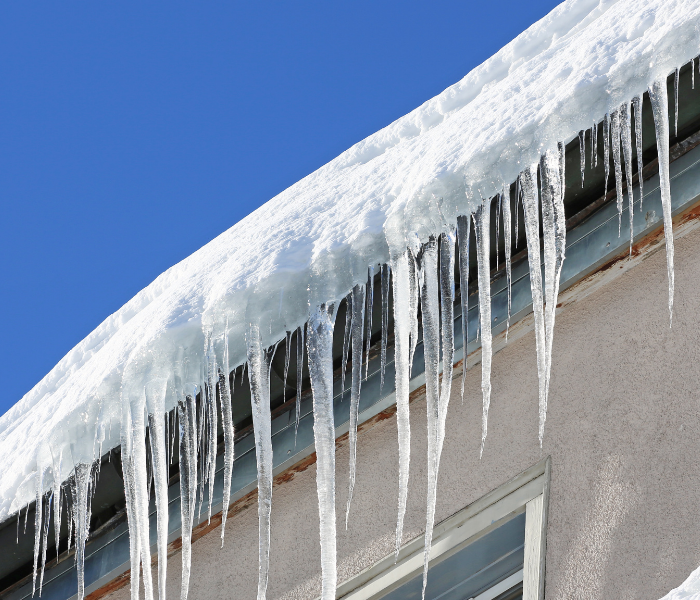 When ice dams cause water damage and mold in Old Lyme, you need immediate assistance to prevent the issue from becoming worse.
When ice dams cause water damage and mold in Old Lyme, you need immediate assistance to prevent the issue from becoming worse.
Roof and ceiling leaks from ice dams in Old Lyme are more common than many homeowners think. When it does occur, snow and ice leaking into your home can cause extensive water damage and mold growth.
If your home is affected by an ice dam roof leak, SERVPRO of Old Saybrook is always ready to provide expert services for ice dam water damage in Old Lyme, CT.
Call Our Office For Immediate Assistance - 860-388-1776
Ice Dam Water Damage Repair Services in Old Lyme, CT
Complete Drying & Dehumidification
Advanced Moisture Detection Equipment
FREE Estimates
Directly Bill Your Insurance Company
The damage from snow and ice leaking into your home requires immediate attention. Without fast action, water damage can spread throughout your home, cause mold growth, and even cause structural issues.
As your local water restoration company, you can trust SERVPRO of Old Saybrook to provide professional ice dam water damage repair in Old Lyme, CT.
Our team has over 15 years of experience, equipped with all the training and resources required to quickly address water damage and mold.
SERVPRO of Old Saybrook also handles the insurance process for you, directly submitting all paperwork, estimates, photos, and more to your insurance company.
When you call SERVPRO of Old Saybrook for damage caused by an ice dam in Old Lyme, our team works hard to make it "Like it never even happened."
Ice Dam Water Damage Restoration Process
SERVPRO of Old Saybrook creates a unique damage restoration plan for each new ice dam water damage in Old Lyme, CT, but the general process still remains the same.
A Project Manager will inspect the damages to your property and create a cleanup and restoration plan.
There may be standing water or saturated carpets due to your ceiling leak from an ice dam in Old Lyme. Our team uses commercial grade extractors to remove excess water and prevent it from damaging other areas of your home.
Using advanced moisture detection and commercial grade drying equipment, SERVPRO of Old Saybrook will completely dry out all affected flooring, insulation, walls and ceilings as needed.
This may include some amount of demolition to ensure that all affected areas are completely dried. Without this step, it's likely for mold and mildew to grow and spread in your property.
Your ice dam roof leak in Old Lyme, CT requires proper cleaning and sanitizing to remove any dirt, bacteria, or lingering mold spores. If the ice dam causes mold growth, our team of mold remediation specialists in Old Lyme can help.
Once the water mitigation process has been completed, there's still the matter of bringing your home back to normal, pre-damage conditions.
Our in-house construction team can seamlessly take over to repair and replace building materials as needed.
Ice Dam Damage: Common Questions
How do ice dams form and cause damage?
These form when your attic is warm, which increases the temperature of your roof and melts snow on the upper areas of the roof.
Melted snow runs down your warm roof, but refreezes at the edges. This refreezing occurs because the edges of the roof extend further than the structure of your home, and isn't warmed by the attic.
Over time, the melted water created a large ridge of ice on the edge of the roof. The pool of water that gets trapped underneath the ice backs up underneath shingles, penetrates the roof deck, and leaks into the attic. This is how you end up with a ceiling leak from the ice dam.
Is ice dam water damage repair in Old Lyme covered by insurance?
Yes, in most cases the cleanup and repairs will be covered by your homeowners insurance company. However, they usually do not cover the cost of dam removal, which can range from $700-1500.
How can you prevent ice dams from forming?
There's a few methods for preventing ice damming, such as:
- Installing better insulation in your attic to limit heat loss from living spaces
- Increase attic ventilation to keep the roof cool
- Use a roof rake to remove heavy snow from your roof before it can melt
- Make sure that no exhaust vents let out into the attic
Ice Dam Water Damage in Old Lyme, CT? Call Today - 860-388-1776
Ice Dam Water Damage Repair in Clinton, CT
11/11/2021 (Permalink)
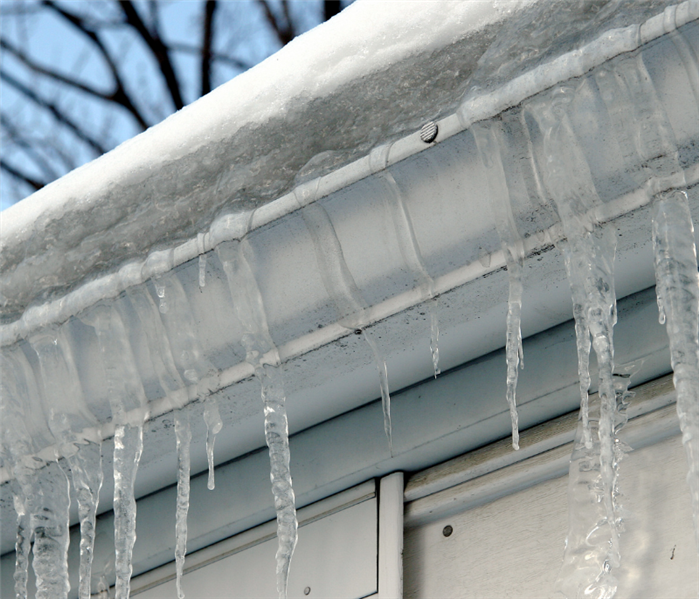 Ice dams cause water damage and mold growth in your Clinton, CT property, requiring professional water restoration services.
Ice dams cause water damage and mold growth in your Clinton, CT property, requiring professional water restoration services.
Roof and ceiling leaks from ice dams in Clinton are more likely to happen than you think. When it does, the leak can cause extensive water damage and mold growth inside of your home.
In fact, ice dams are one of the top 5 causes of winter water damage, according to The Hartford Insurance Company.
If your home is affected by an ice dam roof leak, SERVPRO of Old Saybrook can provide expert services for ice dam water damage in Clinton, CT.
Call Our Office For Immediate Assistance - 860-388-1776
Ice Dam Water Damage Repair Services in Clinton, CT
Complete Drying & Dehumidification
Advanced Moisture Detection Equipment
FREE Estimates
Directly Bill Your Insurance Company
When ice dams form and cause water to leak into your home, the issue needs immediate attention. Without fast action, ice dams can cause mold growth, structural issues, cause wet insulation in your attic, and more.
As your local water damage restoration company, you can trust SERVPRO of Old Saybrook to provide professional ice dam water damage repair in Clinton, CT.
With over 15 years of experience, our team has all the training and resources needed to quickly address water damage and mold. SERVPRO of Old Saybrook also simplifies the insurance process, directly submitting all needed paperwork, documentation, estimates, and more to your insurance company.
When you call SERVPRO of Old Saybrook for ice dam repair services, we'll make your damage "Like it never even happened."
Ice Dam Water Damage Restoration Process
SERVPRO of Old Saybrook creates a unique damage restoration plan for each new ice dam water damage in Clinton, CT, but the general process still remains the same.
A Project Manager will inspect the damages to your property and create a cleanup and restoration plan.
There may be standing water or saturated carpets due to your ceiling leak from an ice dam in Clinton. Our team uses commercial grade extractors to remove excess water and prevent it from damaging other areas of your home.
Using advanced moisture detection and commercial grade drying equipment, SERVPRO of Old Saybrook will completely dry out all affected flooring, insulation, walls and ceilings as needed.
This may include some amount of demolition to ensure that all affected areas are completely dried. Without this step, it's likely for mold and mildew to grow and spread in your property.
Your ice dam roof leak in Clinton, CT requires proper cleaning and sanitizing to remove any dirt, bacteria, or lingering mold spores. If the ice dam causes mold growth, our team of mold remediation specialists in Clinton can help.
Once the water mitigation process has been completed, there's still the matter of bringing your home back to normal, pre-damage conditions.
Our in-house construction team can seamlessly take over to repair and replace building materials as needed.
FAQ: Ice Dams
How do ice dams form and cause damage?
These form when your attic is warm, which increases the temperature of your roof and melts snow on the upper areas of the roof.
Melted snow runs down your warm roof, but refreezes at the edges. This refreezing occurs because the edges of the roof extend further than the structure of your home, and isn't warmed by the attic.
Over time, the melted water created a large ridge of ice on the edge of the roof. The pool of water that gets trapped underneath the ice backs up underneath shingles, penetrates the roof deck, and leaks into the attic. This is how you end up with a ceiling leak from the ice dam.
Is ice dam water damage repair in Clinton covered by insurance?
Yes, in most cases the cleanup and repairs will be covered by your homeowners insurance company. However, they usually do not cover the cost of dam removal, which can range from $700-1500.
How can you prevent ice dams from forming?
There's a few methods for preventing ice damming, such as:
- Installing better insulation in your attic to limit heat loss from living spaces
- Increase attic ventilation to keep the roof cool
- Use a roof rake to remove heavy snow from your roof before it can melt
- Make sure that no exhaust vents let out into the attic
Ice Dam Water Damage in Clinton, CT? Call Today - 860-388-1776
Ice Dam Water Damage Repair in Madison, CT
11/8/2021 (Permalink)
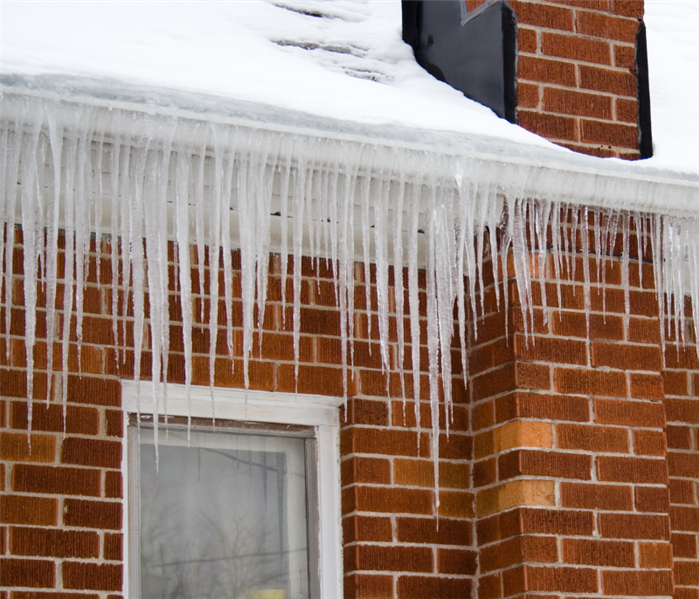 When ice dams cause roof leaks, SERVPRO of Old Saybrook can provide expert water damage repair services in Madison, CT.
When ice dams cause roof leaks, SERVPRO of Old Saybrook can provide expert water damage repair services in Madison, CT.
Ice dams in Madison, CT happen more than most homeowners would like, and can cause extensive water damage throughout your home.
In fact, The Hartford Insurance Company has stated that ice dam water damage in Madison, CT is one of the top 5 causes of damages in the winter, costing about $7,000 per claim.
If your home is affected by an ice dam roof leak, SERVPRO of Old Saybrook can provide expert ice dam water damage repair in Madison, CT.
Call Our Office Today For Immediate Assistance - 860-388-1776
Professional Ice Dam Water Damage Restoration in Madison, CT
Complete Drying & Dehumidification Services
Advanced Moisture Detection Equipment
FREE Estimates
Directly Bill Your Insurance Company
When ice dams leak into your home, the issue needs immediate attention. As your local water damage restoration company in Madison, CT with over 15 years of experience, you can trust SERVPRO of Old Saybrook to quickly restore your home or business to pre-damage conditions.
Our team of IICRC water restoration specialists have all the training, experience, and resources needed to provide expert ice dam water damage repair in Madison, CT. Our entire team can answer any questions or concerns about your restoration project or the insurance process.
In fact, SERVPRO of Old Saybrook will handle the insurance process for you, from submitting estimates, photos, getting approvals, and more directly from your insurance company.
When you call SERVPRO of Old Saybrook for ice dam repair services, we'll make your ice dam in Madison, CT "Like it never even happened."
Ice Dam Water Damage Restoration Process
SERVPRO of Old Saybrook creates a unique damage restoration plan for each new loss, but the general process still remains the same.
A Project Manager will inspect the damages to your property and create a cleanup and restoration plan.
There may be standing water or saturated carpets due to your ceiling leak from the ice dam. Our team uses commercial grade extractors to remove excess water and prevent it from damaging other areas of your home.
Using advanced moisture detection and commercial grade drying equipment, SERVPRO of Old Saybrook will completely dry out all affected flooring, insulation, walls and ceilings as needed.
This may include some amount of demolition to ensure that all affected areas are completely dried. Without this step, it's likely for mold and mildew to grow and spread in your property.
Your ice dam roof leak in Madison, CT requires proper cleaning and sanitizing to remove any dirt, bacteria, or lingering mold spores. If the ice dam causes mold growth, our team of mold remediation specialists in Madison can help.
Once the water mitigation process has been completed, there's still the matter of bringing your home back to normal, pre-damage conditions.
Our in-house construction team can seamlessly take over to repair and replace building materials as needed.
Ice Dam Repair: Common Questions
How do ice dams form on my roof?
Ice dams form when your attic is warm enough to increase the temperature of your roof, which melts snow on the upper areas of the roof.
Melted snow runs down the roof, but refreezes at the edges. This is because the edges of the roof extend further than the structure, and aren't warmed by the attic.
Over time, the melted water created a large ridge of ice on the edge of the roof. The pool of water that gets trapped underneath the ice backs up underneath shingles, penetrates the roof deck, and leaks into the attic. This is how you end up with a ceiling leak from the ice dam.
Is ice dam water damage repair in Madison covered by insurance?
Yes, in most cases the cleanup and repairs will be covered by your homeowners insurance company. However, they usually do not cover the cost of dam removal, which can range from $700-1500.
How can you prevent ice dams from forming?
There's a few methods for preventing ice damming, such as:
- Installing better insulation in your attic to limit heat loss from living spaces
- Increase attic ventilation to keep the roof cool
- Use a roof rake to remove heavy snow from your roof before it can melt
- Make sure that no exhaust vents let out into the attic
Ice Dam Water Damage Restoration in Madison, CT - Call Today - 860-388-1776
Ice Dam Water Damage in Old Saybrook, CT
1/12/2021 (Permalink)
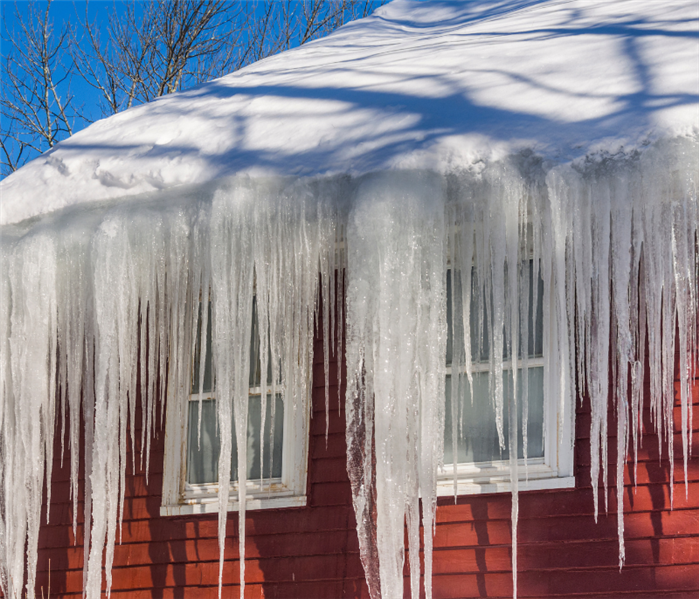 Ice dam water damage can affect multiple levels of your Old Saybrook home, requiring extensive water damage restoration services.
Ice dam water damage can affect multiple levels of your Old Saybrook home, requiring extensive water damage restoration services.
When ice dams form on the roof of your Old Saybrook home, you may be in for trouble. If not promptly removed, they can cause serious damage both inside and outside of your home.
When you need help dealing with the water damage from an ice dam, call the water damage restoration specialists at SERVPRO of Old Saybrook for immediate assistance.
What Is An Ice Dam and How Do They Cause Water Damage?
An ice dam is a large ‘wall’ of ice that forms on the edge of your roof and in your gutters. These most often form after a heavy snow and low temperatures. The problem with ice dams is that they prevent melting snow from draining off of your roof. This causes the dam to grow larger and larger as snow and ice melts.
Ice dams form because of above-freezing temperatures in your attic, which cause the roof to warm and melt snow. Since the edges of your roof stay below freezing, melted snow refreezes and forms the ice dam.
Ice dams cause water damage because the water that is trapped behind the dam penetrates your roof. Once water gets past shingles and hits the sheathing of your roof, it will begin to cause water damage in your attic.
Damages that ice dams cause include:
- Water damage in attic
- Wet insulation
- Water damage to ceilings, walls, and floors
- Ceilings leaks and roof leaks
- Warping of walls, ceilings, or floors
- Bubbling or peeling paint
- Mold growth in affected areas
- Roof damage
Ice Dam Water Damage Repair Services
Once you realize an ice dam is causing water damage in your Old Saybrook home, you should take immediate action. By calling the ice dam water damage restoration specialists at SERVPRO of Old Saybrook, you can be sure all damages are quickly taken care of.
Our ice dam water damage repair process:
- Emergency Contact - A representative will take all your contact information and ask questions about your damages. Questions asked include: When did the leak start? Is it still leaking? What areas are affected by water? Is there mold growth? Have you filed an insurance claim? Do you need the ice dam removed?
- Water Cleanup - Once our team arrives on site, they rapidly begin removing any standing water in your home.
- Drying Services - Commercial grade fans, dehumidifiers, and floor drying mats are used to ensure all moisture is removed from building materials.
- Demolition - Since ice dams leak through ceilings and behind walls, some amount of demolition is likely required to ensure all affected areas are dried out.
- Cleaning and Sanitizing - Our team cleans and sanitizes the affected areas to ensure no dirt, debris, bacteria, or mold spores are left behind.
- Restoration - Our in house construction team can take over to make any needed repairs to your roof, walls, floors, ceilings, or paint as needed.
Common Questions
Are ice dams covered by insurance?
Most of the time the water damage resulting from an ice dam leak will be covered by your insurance company. Unfortunately, they may not cover the cost of ice dam removal, which is around $1,000.
Can I remove ice dams myself?
While there are methods for DIY ice dam removal, we recommend calling in professionals. Getting on an icy roof can be dangerous and DIY removal can end up causing more damage to your roof.
Can you prevent ice dams?
Yes, ice dams can be prevented. You should take steps to better insulate your attic from your living space, maximize air flow from outside on your roof, and remove excess snow before it has a chance to form an ice dam.
Get Help With Ice Dam Water Damage in Old Saybrook Today - 203-388-1776
How To Spot Wind Damage To Your Roof
12/8/2020 (Permalink)
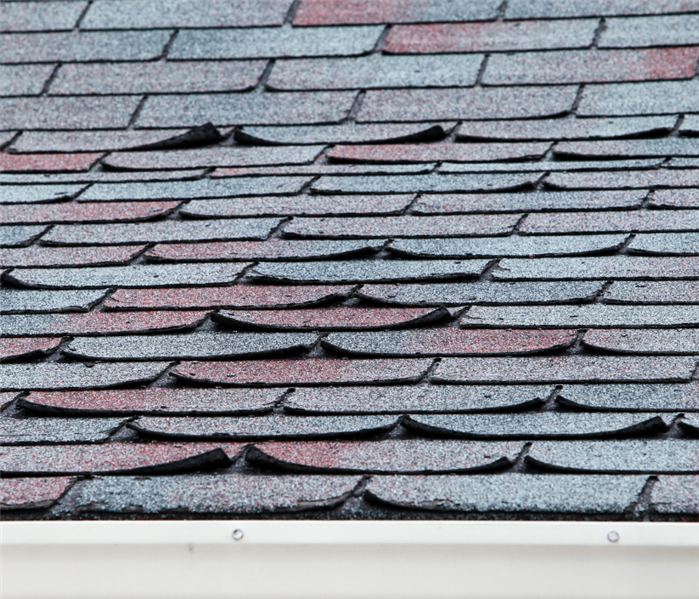 High winds can cause many different types of damage to your roof, and can spell trouble for the rest of your home.
High winds can cause many different types of damage to your roof, and can spell trouble for the rest of your home.
When strong storms come through your area, high wind speeds can cause roof storm damage even without falling debris or hail. Here, we will review what wind damage is and how to identify it on your roof.
What is Wind Damage?
Wind damage is any damage done to your roof because of high winds. This damage is usually more common on the corners, edges, and ridge line of the roof. This is because winds do not hit the surface of the roof evenly and more strongly hit these areas.
When you experience a storm with wind speeds above 45 miles per hour, your home is at risk of roof damage. The stronger winds there are, the more damage that can be done to your roof.
- Winds of 45-57 mph can tear down tree branches and remove loose shingles.
- Wind speeds of 58-74 mph can tear down trees and rip shingles right off your homes roof.
- Winds of 75-89 mph can cause widespread tree damage, flip cars or mobile homes, or cause severe roof damage to commercial buildings which usually have flat tops.
- Lastly, winds of over 90 mph will cause significant damage to homes.
The damages caused by strong winds should not be ignored, as the consequences of high winds can spread to other parts of your home.
Identifying Wind Damage on Your Roof
Any time there are higher than average winds, you should take a moment to inspect your roof for any of these signs of damage. If you suspect any damage, you should call a roofing contractor to come to further inspect your roof and explain what repairs need to be made. Keeping your roof in good condition will help to prevent large scale storm damage down the line.
Signs of Wind Damage:
- Granules Missing From Asphalt Shingles - High winds can cause the loss of granules, which are the sandpaper-like portion of the shingle. Granule loss over time is normal, but it should be concerning when you spot more loss than usual. You can look in your gutters for granule buildup, as they usually flow right into them. Losing granules on your shingles causes them to grow weaker over time.
- Curling Shingles - Curling shingles are usually found on the areas of the roof that sustain the most wind (edges, corners, at the ridge, near the chimney). This happens when wind gets under a small piece of the shingle and forces it up.
- "Lifting" Shingles - Similar to curling shingles, lifting shingles have wind get under them and cause their damage. Rather than curling, the nails of these shingles loosen and lift the entire shingle up, and can break the sealant between the shingle layer and possibly expose the lower portion of the roof. From the ground, this type of wind damaged shingles are hard to spot, as they are not as obvious as curled or completely missing shingles.
- Entire Shingles Missing - This is probably the easiest way to spot wind damage to your roof, as it is easy to identify an area where a shingle is missing.
- Damaged Soffit or Fascia - Fascia is the long, straight board the run along the lower edge of the roof, while soffit is directly on the underside of the fascia. Both of these help prevent moisture from reaching inside the roof. Damage to these may look like hanging or ripped off soffit or fascia.
- Damaged Chimney - The chimney will take on higher wind levels than most of the roof, making it susceptible to storm and wind damage. If you see damaged flashing around the base of the chimney or cracks or missing bricks, it may have been damaged by high winds.
- Roof Leaks - When your roof sustains any of the damages above, it will be highly susceptible to roof leaks. You should inspect inside your home or attic of any signs of water damage or leaks and have the damage addressed immediately, as water damage can continue to spread throughout your home and even cause mold growth.
What To Do When You Find Wind Damage
If you have clear and obvious wind damage that needs to be handled right away, you should contact your insurance company and file a claim. Then, you should call a reputable roofing contractor to provide a roof inspection and detail what needs to be repaired. Don't take wind damage lightly, as it will lead to further roof damage and increase the likelihood of roof leaks and water damage in your home.
Sump Pump Flooded Basement - Causes & What To Do
12/1/2020 (Permalink)
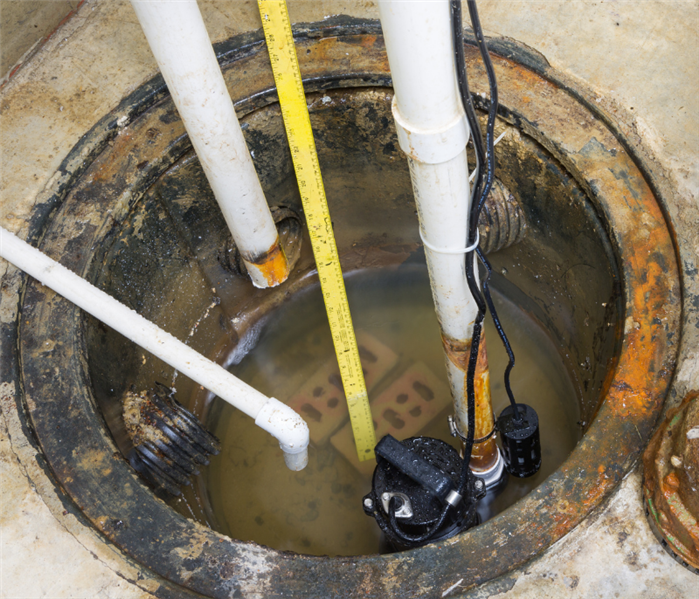 Sump pump failures can flood your entire basement.
Sump pump failures can flood your entire basement.
Reasons your sump pump may cause a flooded basement in Old Saybrook and what you should do when it happens.
Many basements have sump pumps installed because it is prone to flooding. Basement flooding is usually due to hydrostatic pressure, or in simpler terms groundwater forcing its way into your basement. Sump pumps help prevent this by sensing rising water levels or pressure. Once water reaches the float switch and activates it, the pump will automatically turn on and pump excess water away from your property using a discharge line.
While these are a great defense against basement flooding, there is still the chance of a sump pump failure for a long list of reasons that causes a flood. Here, we will review why and what to do when your sump pump fails.
Why Do Sump Pumps Fail?
Power Loss
Many pumps need a power source or else they will not turn on. Its possible that during a strong storm (when you would need your pump most) that the power will go out. When groundwater rises from the storm, the pump will not be able to turn on and cause your basement or crawlspace to flood.
There are other times where homeowners have unplugged their pumps to clean them out, but forgotten to plug them back in. These cases are unfortunately and will also lead to a flooded basement when groundwater rises.
What to do: If your basement needs a pump to prevent flooding, be sure to invest in a backup sump pump. Battery backup pumps will still work when a fuse blows or a storm causes a power outage.
Overwhelmed Pump
If you notice that your pump is not efficiently working and your basement is still wet or flooding, you may have an overwhelmed pump. Sometimes one pump isn't enough to handle the volume of water entering the basement especially during a heavy rainstorm.
What to do: Depending on your basement, you may need a higher quality pump or even more than one pump located at separate corners of the basement. This should stop one pump from working overtime and keep your basement dry.
Clogged Pumps and Float Switches
Over time, pumps may become dirty and collect debris that will cause the pump to work less efficiently or stop working altogether. Dirt and debris in the sump pit will cause other components of the pump to also become clogged or dirty. This can be a huge problem when the float switch, which turns the pump on and off, becomes clogged. A dirty sump pump will very likely cause your basement to flood.
Another cause for a clogged pump can be the impeller. The impeller filters debris from the water pump, helping to keep it clean and clear. When this filter is clogged, it may make a strange noise or prevent the pump from running - or cause other components to become clogged as well.
What to do: Make sure that your pump has a airtight sealed lid to help prevent debris from getting into it. Have it inspected every so often to be sure it doesn't need to be cleaned, repaired, or replaced before it is too late.
Sump Pump Running Non-Stop
When pumps run nonstop, it can start to overheat and breakdown, especially when there is not any water in the sump pit to naturally cool the system as it works. Pumps usually run non stop because there is a stuck float switch stuck in the on position. This issue can also be contributed to water not exiting through your discharge line and repeatedly flowing back to the sump pump, causing it to turn on over and over again.
What to do: In these cases, there are a few different things you could do. For a stuck float switch, you may have to clean out the pump or replace it with a new switch. If water continually flows back to your sump pump from the discharge pipe, you can install a check valve that will prevent water from flowing back to the pump and turning it on.
Age
Sump pumps need to be replaced every 7-10 years depending on how much they are used. When your pump is old, it can simply fail due to old age. At some point, every pump motor will burn out and no longer turn on.
What to do: Pay attention to how long your pump has been installed for and look out for signs that it may be on its way out. Signs your sump pump will soon need to be replaced are loud noises such as rattling, clanging, or screaming motors. The pump constantly running can also be a sign that it needs to be replaced.
Common Questions
How do you know if the sump pump is not working?
The answer to this question may be very obvious, but you can usually assume your pump is working if it does not overflow and your basement doesn't flood during heavy rainstorms. You are not supposed to hear your pump loudly running from your living space, so don't expect to hear it turn on every time.
Can I unplug my sump pump?
Yes, you can unplug your sump pump for a short amount of time so long as your remember to plug it back in. Many homeowners unplug it to inspect and clean it - but you must not forget to plug it back in.
Does insurance cover sump pump failures?
Unless you purchase special coverage for your pump, the cleanup for its failure will not be covered by your insurance company. This is because the water that enters the basement is groundwater, which is traditionally not covered unless you have supplemental coverage.
Checklist For Preparing For A Blizzard
11/16/2020 (Permalink)
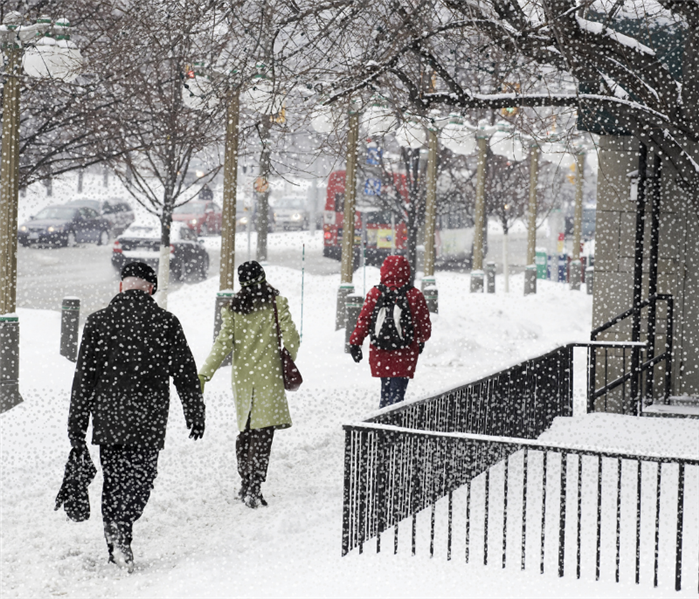 Follow this checklist to be prepared in case of an extreme blizzard this winter.
Follow this checklist to be prepared in case of an extreme blizzard this winter.
Here in New England, winter storms are nothing new. Most households are no stranger to preparing for snow throughout the winter season. But, there are times when extreme weather rolls through and brings blizzards that can last days and keep you snowed in for even longer.
When you know a blizzard is coming your way, you should be sure to take steps to prepare for low outdoor visibility, extreme cold, possible power outages, and even disruption to usual emergency services. Follow this checklist to prepare for a blizzard and keep your family safe and warm, even if you’re snowed in.
Preparing For A Blizzard: Checklist
- Prepare or replenish your emergency survival kit. Your kit should have all the supplies needed in the event of an emergency or major disaster, and should be able to last for days. Your kit should also be easy to carry in case you must evacuate your home. According to the Red Cross, your emergency kit should at minimum contain the following:
- Water - One gallon per person, per day
- Food - Non-perishable items that are easy to prepare, even without power
- Flashlight - Battery powered and hand-crank is best
- Radio - Battery powered or hand-crank
- Extra batteries
- Complete first aid kit
- Enough of your everyday medication to last 2 weeks
- A multi-purpose tool
- Personal hygiene items
- Copies of all important personal documents
- Cell phones and chargers
- Emergency contact information
- Extra cash
- Emergency blanket
- Pet supplies (if you have one)
- Have your vehicle ready in case of emergencies or evacuation. Fill up your gas tank and make sure it is ready to drive in the snow. Keep a shovel and kitty litter in your car in case you get stuck in the snow.
- Charge electronic devices. Make sure phones are charged along with any portable chargers you may own.
- Prepare your home. It’s best to storm proof your home every winter to keep it better insulated from the cold - but this is even more important during a blizzard, especially if you lose power. Apply weather-stripping to doors and windows and seal any cracks or air gaps. Insulate pipes, especially those on the exterior walls of your home so they do not freeze and burst during the storm.
- Gather warm clothing. In case the worst happens, having thick, layered clothing is a must to stay warm. Gather any winter hats or gloves you may also have around the house.
- Bring any outdoor animals inside or move them to a safe place. If you wouldn’t want to be out in the storm - neither do your animals. Be sure to give them enough food, water, and shelter to last the blizzard.
- Arrange for a secondary heating source. If you have a fireplace, stock up on firewood. If using a portable generator, remember to get fuel and store it in an airtight gas can (not in your living space).
- Test or install fire and carbon monoxide detectors. This is important in case the power goes out and you utilize a fireplace, portable generator, or candles for light or heat.
- Buy a snow shovel before the snow starts. Without a shovel, you may be stuck in your house for longer than planned. Getting ice melt, salt, or sand will also be helpful. We recommend purchasing all of this at the beginning of the winter season to beat the pre-storm store rush.
- Research where you can get shelter if you cannot stay in your home. If the power goes out for an extended amount of time or a tree falls on your home during the blizzard, you will want to know where the closest shelter is or have arranged to stay with friends or family.
- Learn the signs of frostbite and hypothermia. If the power goes out or you are stranded in the cold, it's important to know the signs of these so you can begin treatment right away.
- Frostbite: Causes loss of feeling and colors around your face, fingers, and toes. Skin may turn white or grayish-yellow. If you suspect frostbite, go to a warm room, soak in warm water, or use body heat to warm. Do not use a heating pad.
- Hypothermia: Unusually low body temperature, under 95 degrees. Signs of this are shivering, exhaustion, confusion, fumbling hands, memory loss, slurred speech or drowsiness. If you suspect hypothermia you can do the following: Go to a warm room, warm the center of the body first (chest, neck, head, groin), keep dry and wrapped in warm blankets.
During the Blizzard
During a blizzard, you should always stay off of the roads if possible. Visibility becomes extremely limited and it’s possible to get stuck where plows have not reached yet. If stranded in a car during a blizzard, keep warm as best you can, use your emergency kit, and call for help.
You should also stay up to date with the latest weather reports throughout the storm. This will keep you informed as to how long the blizzard will last, how much snow and ice to expect, and will provide any updates in case of evacuation.
Also be sure to keep all windows, doors, curtains, or blinds closed during a blizzard. This helps keep as much heat as possible inside your house and prevent cold drafts from outside.
If you follow the checklist above, you and your family should be able to stay safe even if your home loses power during the blizzard. Staying warm, hydrated, and eating enough should be sufficient until you can stay in a place with power or power returns to your home.
Water Damage From Gutters: Signs & Prevention
10/21/2020 (Permalink)
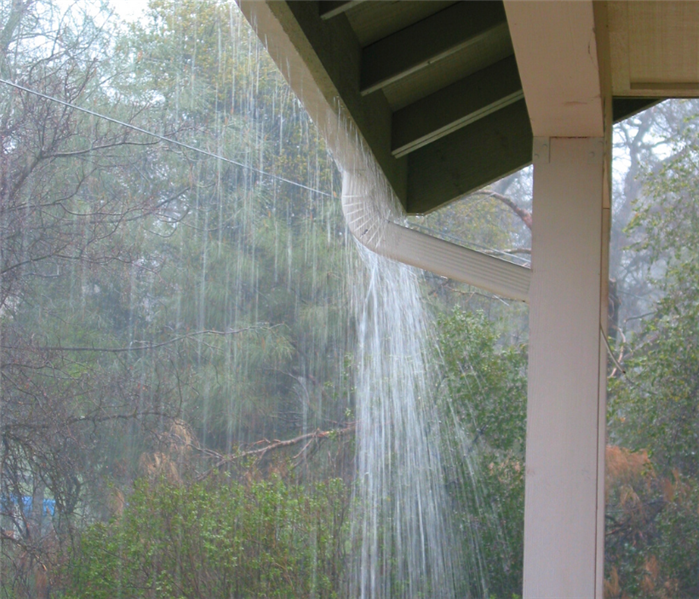 Overflowing gutters are easy to fix, but the surprising damages that come from them are not.
Overflowing gutters are easy to fix, but the surprising damages that come from them are not.
It may not be obvious, but the gutters of your home can be a major culprit of water damage. Your gutter system is designed to carry water away from your home, helping to protect it from flooding and structural damages. Gutters also protect the siding of your home and window frames from water damage.
When gutters are clogged, heavy rains can cause them to overflow and direct gallons of water directly down the side of your house and to the ground below - Doing the exact opposite of what they are designed to do. Blocked gutter damage can cause huge problems for your home inside and out. Here, we will review the signs of damage from gutters and what you can do to prevent it.
Signs Clogged Gutters Are Causing Water Damage
- Water Flowing Down Siding - When water in your gutters cannot flow down the downspouts, it overflows and runs down the exterior wall. Although the siding of your home is designed to withstand water, they are not completely waterproof, meaning that they will not withstand a constant flow of water. This constant flow will eventually seep behind the siding, penetrate the exterior sheathing of your home, and find it's way to the living space of your home.
- Higher Levels of Groundwater - The overflowing water from the clogged gutter saturates the ground immediately below. This increase of groundwater directly outside the foundation of your home increases hydrostatic pressure on your foundation and makes basement flooding more likely.
- Cracks in the Foundation - The amount of water flowing directly to the foundation of your home can wear it down, shift it, and cause cracks and buckling.
- Basement Flooding When It Rains - As mentioned earlier, the higher level of groundwater makes it more likely that your basement will be wet when it rains. Clogged gutters cause water in basements.
- Rotting Wood - If you notice wood on your roof, soffit, or fascia boards of your home, it is likely due to standing water from overflowing gutters. Even a few hours of standing water can cause wood to begin to rot.
- Water in Attic - Clogged gutters become heavy due to the weight of trapped water and may begin to pull away from your home. When this happens, it can pull at the soffit and fascia of the roof and allow water to flow into the attic causing water damage and mold growth.
The water damage from clogged gutters can affect every level of your home, from the attic to the basement.
Preventing Blocked Gutter Damage
Preventing your gutters from overflowing and causing water damage to your home is quite easy. All you have to do is clear out any debris from your gutters at least once a year. This is most important to be done towards the end of fall and in the spring, as these are the times of year where the most debris may be caught in your gutters.
When cleaning out your gutters, be sure to take proper safety steps. Find a tall enough ladder, thick gloves, buckets, and a hose to clear debris out. Be sure to have someone at the bottom of your ladder in cause you lose stability or lose your grip.
What Are The Warning Signs of A Tornado?
10/19/2020 (Permalink)
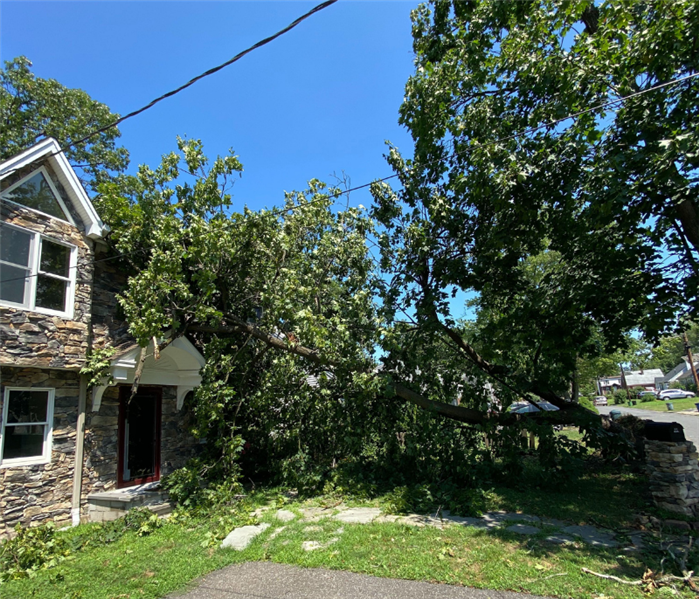 Finding safe shelter is the most important thing to do when you have a tornado warning in your area.
Finding safe shelter is the most important thing to do when you have a tornado warning in your area.
Warning Signs of a Tornado
If you see these warning signs of a tornado, go inside immediately and check your local weather announcements for watches or warnings. Tornadoes can hit seemingly out of nowhere and destroy everything in their path - flipping cars, uprooting trees, and even taking the roof off of homes or businesses.
- Dark, green tinted sky
- Wall clouds, or a cloud of debris
- A funnel-shaped cloud
- Large hail without rain
- Roaring noise, similar to a freight train
- Unusual calmness of wind
What’s The Difference Between A Tornado Watch Vs. Warning?
A tornado watch means that the current outdoor weather conditions are just right for a tornado to form. When you receive notification of a warning, you should continue watching your local weather announcements and avoid going outside until you’ve been told it has passed.
A tornado warning means that the weather is right for a tornado and one has been identified in your surrounding area. When you receive notification of a warning, immediately find shelter and take cover.
What Should You Do When A Tornado Hits?
If you have a tornado warning in your area, according to ready.gov you should do the following:
- Go inside the nearest building if possible.
- Go to a safe room, basement or cellar. If there is no basement, take shelter in a small interior room on the lowest floor of the building.
- Stay away from all windows, doors, or outside walls.
- Stay away from bridges or overpasses if possible - look for low, flat locations to take shelter if you’re outside or in your car.
- Stay aware of any flying debris that can injure you if you are outside.
- Use your arms to protect your head and neck regardless of where you are.
During a tornado, you should do the following:
- Stay in your safe location and do not leave until you know it is safe to do so.
- Better protect yourself from flying or falling debris by putting your arms around your head and neck and barricading furniture or blankets around you to protect from heavy objects.
- Listen to your local emergency or weather station for updates.
- Do not try to outrun tornadoes in a car. Find a relatively sheltered, low place where you can put your arms over your head and crouch.
What Do You Do After?
- Continue listening for weather updates to be sure nothing else is coming your way.
- If you are trapped, cover your mouth to try and not breath in dust or debris. Send a text, bang on a wall or a pipe, or whistle instead of yelling for help.
- Stay clear of any fallen power lines or trees.
- Do not reenter buildings that have been damaged until you're told they are safe (This will likely not be the same day).
- When cleaning up any debris, be sure to wear thick gloves and work boots for safety.
- Call your insurance company if your home or business has been damaged by the tornado.
Need Help After A Storm? Call SERVPRO- 800-734-3213
SERVPRO of Old Saybrook is a 24/7 damage restoration company specializing in water damage, storm damage, fire damage, and mold remediation. Whatever the disaster, we work hard to make it "Like it never even happened."
Winter Storm Damage Preparedness in Old Saybrook
1/2/2020 (Permalink)
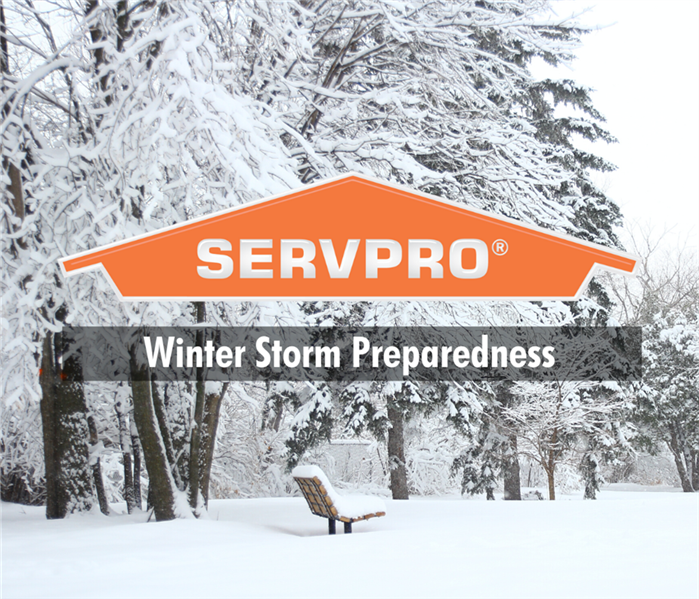 Stay safe and prepared for winter storm damage this winter with SERVPRO's tips!
Stay safe and prepared for winter storm damage this winter with SERVPRO's tips!
Winter storms can cause just as much damage to your home as a summer storm. Snow storms can bring freezing temperatures, feet of snow and ice, and high winds. Power can go out and roads may become hazardous. Preparing for a storm is the best way to keep your family and home safe!
Winter Storm Preparations
- Weatherproof / Winterize your home.
- Add extra insulation in your attic, insulate doors & windows, and insulate any water lines along exterior walls so they are less likely to freeze.
- This will help prevent ice dams from forming as well.
- Keep as much heat as possible in your home during a storm.
- Avoid unnecessary opening of doors or windows, close off unneeded rooms, and close curtains on windows at night.
- You don't want your pipes to freeze and burst!
- Organize a back-up heating source if the power goes out.
- Gas or log fireplaces, portable heaters.
- Make sure you have flashlights and batteries handy.
- Using flashlights is a safer option than using candles all around your home.
- Leave all water taps slightly on so they drip continuously.
- This helps prevent frozen pipes or burst pipes.
Call SERVPRO of Old Saybrook if your home sustains any storm damage this winter.
We are available 24/7 for emergency services, and work with your insurance company - so you don't have to!
800-734-3213
Source: prep4agthreats.org
Free Storm Damage Inspection
10/14/2019 (Permalink)
Free Damage inspection, a detailed damage report.
When it comes to storm damage, there are several types of damage for each area of your home. It is recommended that you act quickly and have a SERVPRO Old Saybrook experienced Storm Damage Specialist begin remediation services immediately. SERVPRO of Old Saybrook will perform a full home damage inspection to include moisture readings onsite. Many times, a homeowner is not aware of the affected areas, especially roof damage.
You will learn a great deal about your home's condition, repair options, and even how we work with your insurance company to provide the highest quality of repairs by professional contractors and installers.
Contact SERVPRO of Old Saybrook today to schedule and learn more about our Professional Storm Damage Cleaning, Drying and Remodeling!
Get Back On Your Feet with SERVPRO of Old Saybrook
10/11/2019 (Permalink)
Storms can occur at any time and can cause large amounts of damage to your residential or commercial property. Heavy rains can cause flooding, powerful winds can cause roof damage, and there are a number of other damages that can occur on your property. Having a strategy to deal with damage will help you to be ready immediately after the storm.
Safety First
After a storm event, there are certain things to be wary of. Electrical devices and outlets can become unstable posing a risk of electrocution. Gas tanks and water mains could begin to leak. And you should always be on the lookout for debris. Keeping yourself safe after a storm is the most important step to take.
Take Photos
After damage occurs from a storm, if conditions allow, take some photos. Any pictures you take can be useful for insurance claim purposes down the line.
Call the Experts
First, call your insurance company to let them know of the damage that has occurred. Then, the best next step to take is to call an expert restoration company. Calling a restoration company can help you to begin the process of restoring your home, and your life, back to normal.
Call SERVPRO of Old Saybrook to help you get back on your feet.
Storm Damage Requires Professional Help
10/9/2019 (Permalink)
Storms and inclement weather can bring wind damage, heavy rain, and flooding that can devastate any business in a matter of minutes. There’s never a convenient time for wind or water damage to strike, and storms don’t just hit during regular business hours. At SERVPRO of Old Saybrook, we offer 24 hour emergency service 365 days a year because we know that every hour you spend cleaning up is an hour of lost revenue and productivity. At SERVPRO, the difference is our ability to dispatch trained production professionals and cut costs through the strategic placement and highly trained crews. So when an emergency situation arises in your business, give us a call to help make your commercial storm damage, “Like it never even happened.”
Get the professionals, call SERVPRO of Old Saybrook.
Storm Damage?
9/30/2019 (Permalink)
Summers in Old Saybrook can certainly bring some harsh weather and storms. If you've noticed that you have storm damage to your home or business it's best to call in the experts right away to reduce the chances of further damage! BUT, some people don’t always know what storm damage can include. If your wondering if the damage your property has can be considered “storm damage” for insurance purposes, check out our quick reference guide below.
Storm Damage Means:
- Fire damage due to lightning
- Flood damage due to rain/flash flooding
- Structural damage to roof, windows, walls, etc. This can be due to wind, hail, or other debris.
Remember, this is not a definite answer on whether your damage will be covered by insurance. However, no matter what kind of damage your property has, SERVPRO of Old Saybrook can handle it. Our team are experts in handling all sorts of damage from shoreline storms AND, we're available 24/7, 365 days a year for all of your storm damage needs! Call SERVPRO of Old Saybrook to make your disaster "Like it never even happened."
Storm Damage to Old Saybrook Property
9/30/2019 (Permalink)
Learn More About How Storms and Wind Can Damage Your Home
When a storm hits in Old Saybrook, there are a number of damages that can be done to your property. Do you know who to call when disaster strikes? SERVPRO of Old Saybrook specializes in restoring properties from damage related to:
- Thunderstorms
- Lightning Strikes
- Hurricanes
- Tornadoes and high winds
- Hail and ice storms
- Freezing weather and ice dams
From tarping your roof to water removal and structural drying, SERVPRO of Old Saybrook can help you.
Cleanup & Repair
Whatever storm damage you have experienced, we are fully equipped to help. Contact us for:
- 24/7 emergency services
- Storm damage assessment
- Water damage repair
- Wind damage repair
- Emergency board up
- Tree Removal
- Structural stabilization
- Reconstruction services
- Insurance claim assistance
If your property has experienced damage from a storm, call the experts. Don’t let a storm damage your property value! Contact SERVPRO of Old Saybrook, CT!
Old Saybrook Hurricane Season
9/24/2019 (Permalink)
2019 Hurricane Season is in full swing. Living in Old Saybrook it's always best to be prepared for when storms hit. These tips will help you to prepare for any storms that may hit our community in the upcoming months.
- Have an Emergency Kit
Making an emergency kit when the storm hits is too late! You need to have a kit prepared so that you're ready before the storm. Your storm emergency kit should include supplies for 3 days of no power. Include items like: flashlights, candles, non-perishable food, water, batteries, blankets, first aid kit, and an extra cellphone battery pack.
- Know Your Zone
Living in Old Saybrook presents unique challenges such as flooding. Be sure to check with your local government officials to find out whether or not you live in a hurricane evacuation zone.
- Review Your Insurance Policy
You should always be prepared and know exactly what type of coverage you have for your home and belongings in case you need it. If you know you live in a hurricane evacuation zone and you don't have flood insurance, you might want to consider purchasing it.
- Know Who to Call
If you find your Old Saybrook home or property damaged after a storm, you need to know who to call. SERVPRO of Old Saybrook can help you with all of your storm restoration needs. We're available 24/7, 365 days a year so no matter your disaster, we'll be there for you!
Old Saybrook - A Year After the Connecticut Tornadoes
6/5/2019 (Permalink)
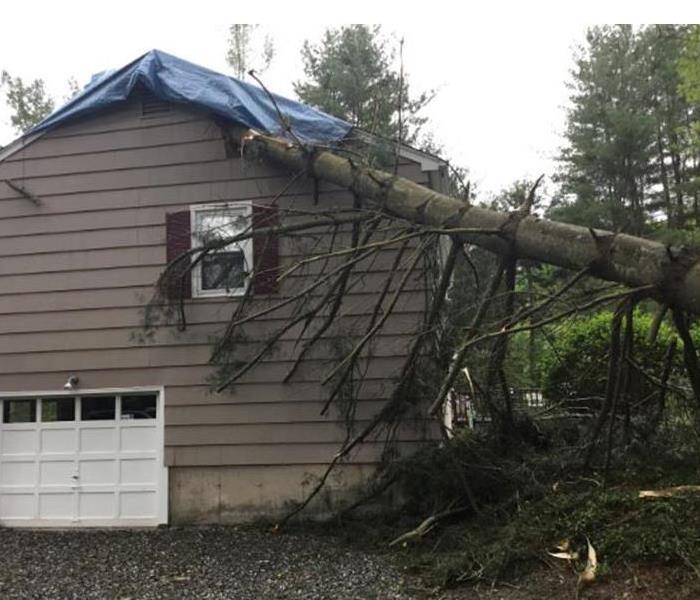 Photo from Cathy Finlayson, a Marketing Rep at SERVPRO of Old Saybrook
Photo from Cathy Finlayson, a Marketing Rep at SERVPRO of Old Saybrook
On May 15th, 2018 Connecticut residents experienced some of the worst weather since 1989.
As many as 4 tornadoes touched down, winds picked up to 110 miles per hour at their peak, and hail the size of tennis balls rained down throughout New Haven county.
For Connecticut residents, this was an unusual and catastrophic event.
Trees fell, homes flooded, and wind and hail did major structural damage.
Luckily, SERVPRO was there to help make it "Like it never even happened."
We helped countless Connecticut residents recover from the damage that ensued following these storms - including pulling trees out of houses!
You can’t predict the weather and you surely can't predict when a tornado will strike in Connecticut but what you can do when disaster strikes - CALL SERVPRO.
Give us a call and we’ll make your emergency "Like it never even happened."
Commercial Storm Cleanup in Old Saybrook
5/29/2018 (Permalink)
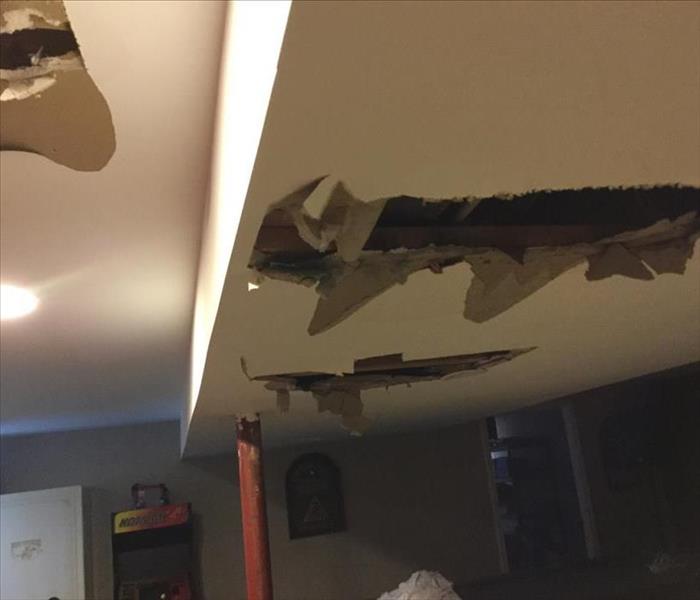 Commercial Storm Cleanup in Old Saybrook
Commercial Storm Cleanup in Old Saybrook
Storms and inclement weather can bring wind damage, heavy rain, and flooding that can devastate any business in a matter of minutes. There’s never a convenient time for flooding or water damage to strike, and storms don’t just strike during regular business hours; that’s why SERVPRO of Old Saybrook, CT offers 24 hour emergency service 365 days per year because we know that every hour you spend cleaning up is an hour of lost revenue and productivity. So when an emergency situation arises in your business, give us a call and we’ll be there fast with the help you need.
The SERVPRO Commercial Large Loss Division is composed of our best of the best in restoration. Our elite large-loss specialists are prequalified and strategically positioned to handle any size disaster.
Also, the SERVPRO Disaster Recovery Team can provide help whether you're dealing with a tornado, hurricane, blizzard or flood. The SERVPRO System has a network of strategically positioned storm teams on standby should a disaster strike near you. Available 24 hours a day and 365 days a year, SERVPRO professionals are prepared for the unpredictable.
At SERVPRO, the difference is our ability to dispatch trained production professionals and cut costs through the strategic placement and highly trained crews. Get the professionals, call SERVPRO.
What Should I Do After My House Is Damaged by a Storm?
5/18/2018 (Permalink)
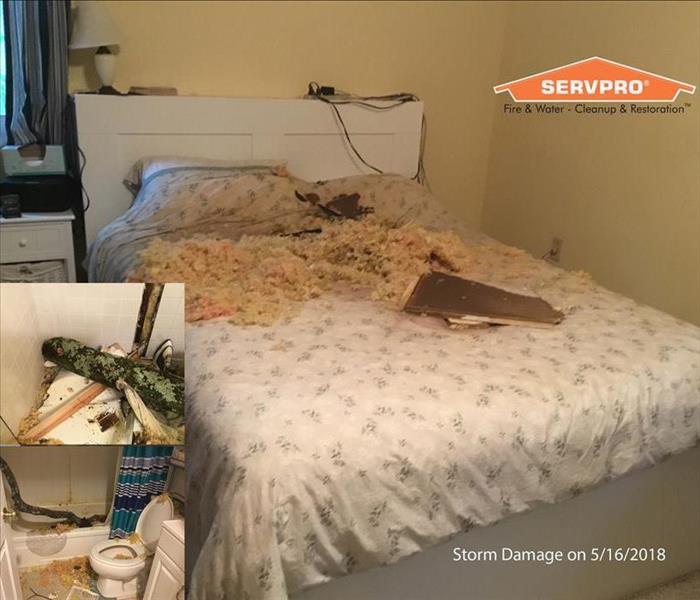 What Should I Do After My House Is Damaged by a Storm in OId Saybrook?
What Should I Do After My House Is Damaged by a Storm in OId Saybrook?
The damage a storm causes to a home can leave your life suddenly upended. In the first days after a storm, you might be overwhelmed with the damage, with everything you have to do and with concerns about getting your life back together. But careful planning can help you return to normalcy as quickly as possible.
Safety First
Whether your house flooded, sustained wind damage or was struck by lightning, the aftermath of a storm can pose serious dangers. Live power lines, mold and open areas of your house can all put you at risk. It's wise to leave your house until you're able to evaluate the damage. Consider going to an emergency shelter, staying with friends and family or staying at a hotel until you're able to get an inspector to your home. Take a few day's worth of clothing and supplies if possible, but prioritize safety above collecting your possessions. Your insurance company might provide someone to inspect your home for safety hazards, or you may need to hire someone, but in either case, you should have your home checked for hazards before you return.
SERVPRO of Old Saybrook CT responds immediately to your flood and storm damage emergencies. We have the storm damage restoration experience and specialized equipment to restore your Old Saybrook home or business back to pre-storm condition.
Have Storm Damage in Old Saybrook, CT? Contact us today. 800-734-3213
Identifying Hail Damage to Your Roof
5/14/2018 (Permalink)
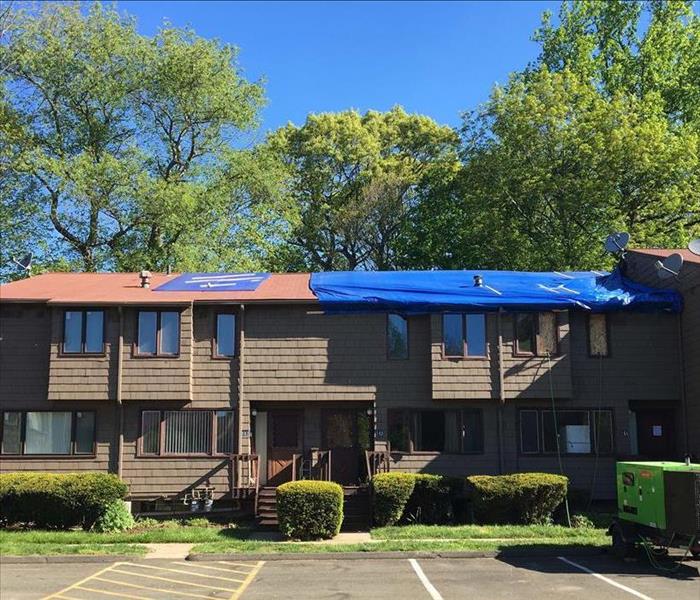 Identifying Hail Damage to Your Roof
Identifying Hail Damage to Your Roof
Are you aware that during a hail storm more than just your vehicles are potentially vulnerable to damage and future repairs? When hail hits, it can damage the roof or covering of your home as well as other personal property. Although hailstorms can be destructive, the amount of damage can vary greatly. Following are some factors that affect the type and degree of damage that may be impacted by a hailstorm, as well as a guide on how to identify hail damage to different types of shingles and roofing materials.
- Wind – During a hailstorm, wind direction and wind speed can vary. Changes in wind conditions can affect the location and severity of hail impacts.
- Size and density – The size of the hailstones can affect the degree of damage, if any, to your property. A hailstone can be as small as a pea, or as large as a softball. Most hailstones do not have smooth edges, which can impact the type of damage they cause.
- Building materials – Building materials absorb hail impacts differently. For example, hail can cause dings in aluminum siding, gutters or asphalt shingles, whereas it can crack vinyl siding or wood shakes. Alternatively, softball-sized hailstones can be dense enough and strong enough to puncture a roof. Additionally, the age and condition of a roof could affect the degree of damage.
- Barriers– The position of neighboring structures and natural barriers, like tree cover, landscaping, fences or adjacent homes can reduce the ability of hail to cause damage.
How to Prepare for a Flood?
11/28/2017 (Permalink)
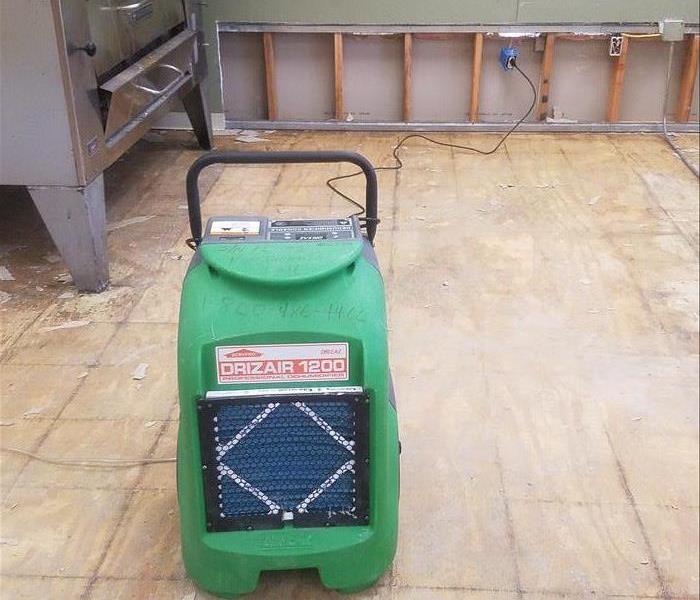 How to Prepare for a Flood?
How to Prepare for a Flood?
Floods are among the most frequent and costly natural disasters. Conditions that cause floods include heavy or steady rain for several hours or days that saturates the ground. Flash floods occur suddenly due to rapidly rising water along a stream or low-lying area.
You will likely hear weather forecasters use these terms when floods are predicted in your community:
- Flood/Flash Flood Watch—Flooding or flash flooding is possible in your area.
- Flood/Flash Flood Warning—Flooding or flash flooding is already occurring or will occur soon in your area.
Prepare
How to Prepare for a Flood
You’ll be better prepared to withstand a flood if you have the following items available – packed and ready to go in case you need to evacuate your home
· · Water—at least a 3-day supply; one gallon per person per day
· Food—at least a 3-day supply of non-perishable, easy-to-prepare food
· Flashlight [Available on the Red Cross Store]
· Battery-powered or hand-crank radio (NOAA Weather Radio, if possible) [Available on the Red Cross Store]
· Extra batteries
· First Aid kit [Available on the Red Cross Store]
· Medications (7-day supply) and medical items (hearing aids with extra batteries, glasses, contact lenses, syringes, cane)
· Multi-purpose tool
· Sanitation and personal hygiene items
· Copies of personal documents (medication list and pertinent medical information, deed/lease to home, birth certificates, insurance policies)
· Cell phone with chargers
· Family and emergency contact information
· Extra cash
· Emergency blanket
· Map(s) of the area
· Baby supplies (bottles, formula, baby food, diapers)
· Pet supplies (collar, leash, ID, food, carrier, bowl)
· Tools/supplies for securing your home
· Extra set of car keys and house keys
· Extra clothing, hat and sturdy shoes
· Rain gear
· Insect repellent and sunscreen
· Camera for photos of damage
Respond
Responding Appropriately During a Flood
· Listen to area radio and television stations and a NOAA Weather Radio for possible flood warnings and reports of flooding in progress or other critical information from the National Weather Service (NWS)
· Be prepared to evacuate at a moment’s notice.
· When a flood or flash flood warning is issued for your area, head for higher ground and stay there.
· Stay away from floodwaters. If you come upon a flowing stream where water is above your ankles, stop, turn around and go another way. Six inches of swiftly moving water can sweep you off of your feet.
· If you come upon a flooded road while driving, turn around and go another way. If you are caught on a flooded road and waters are rising rapidly around you, get out of the car quickly and move to higher ground. Most cars can be swept away by less than two feet of moving water.
· Keep children out of the water. They are curious and often lack judgment about running water or contaminated water.
· Be especially cautious at night when it is harder to recognize flood danger.
· Because standard homeowner’s insurance doesn’t cover flooding, it’s important to have protection from the floods associated with hurricanes, tropical storms, heavy rains and other conditions that impact the U.S. For more flood safety tips and information on flood insurance, please visit the National Flood Insurance Program Web site at www.FloodSmart.gov.
Recover
Flood Recovery Tips
· Return home only when officials have declared the area safe.
· Before entering your home, look outside for loose power lines, damaged gas lines, foundation cracks or other damage.
· Parts of your home may be collapsed or damaged. Approach entrances carefully. See if porch roofs and overhangs have all their supports.
· Watch out for wild animals, especially poisonous snakes that may have come into your home with the floodwater.
· If you smell natural or propane gas or hear a hissing noise, leave immediately and call the fire department.
· If power lines are down outside your home, do not step in puddles or standing water.
· Keep children and pets away from hazardous sites and floodwater.
· Materials such as cleaning products, paint, batteries, contaminated fuel and damaged fuel containers are hazardous. Check with local authorities for assistance with disposal to avoid risk.
· During cleanup, wear protective clothing, including rubber gloves and rubber boots.
· Make sure your food and water are safe. Discard items that have come in contact with floodwater, including canned goods, water bottles, plastic utensils and baby bottle nipples. When in doubt, throw it out!
· Contact your local or state public health department to see if your water supply might be contaminated. You may need to boil or treat it before use. Do not use water that could be contaminated to wash dishes, brush teeth, prepare food, wash hands, make ice or make baby formula!
Let Your Family Know You're Safe
If your community has experienced a disaster, register on the American Red Cross Safe and Well web site to let your family and friends know about your welfare. You may also call 1-866-GET-INFO to register yourself and your family.
http://www.redcross.org/get-help/prepare-for-emergencies/types-of-emergencies/flood#/Recover
Steps to Take Immediately After Storm Damage!
11/17/2017 (Permalink)
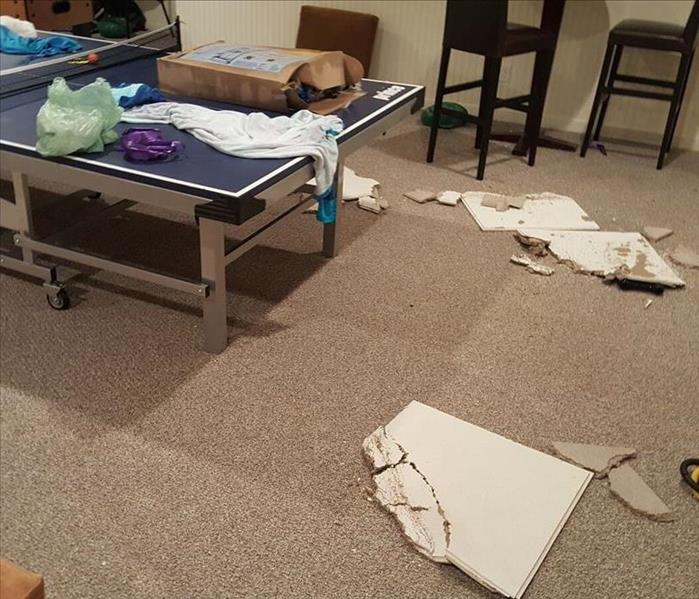 Steps to Take Immediately After Storm Damage!
Steps to Take Immediately After Storm Damage!
Storm damage can occur at any time and can cause an immense amount of harm to your home. Heavy rains can cause flooding, and powerful winds can cause roof damage plus downed trees on your property. Some post-storm damage can create safety and health hazards as well, so having a strategy to deal with damage will help you to be ready immediately after the storm.
Take Safety Precautions
Heavy winds and rain can create physical hazards such as collapsed roof materials, window damage, collapsed walls or standing water in the basement or home interior. In addition, moisture can soak into furniture, carpeting, and building materials making the perfect environment for mold growth that can cause health issues. Shut off the main gas line if you smell gas. Beware of broken glass, exposed nails, and other sharp objects on the property. Contact a reputable property restoration company to help secure your property and make it safe for your family’s use. If necessary, arrange for an alternative place for you and your family to live while your property is being restored to safe living conditions.
Photograph the Damage
If it is safe to move around your property, photograph the damage so that you have a record for your insurance company. This action will ensure that you are fully compensated.
Contact Your Insurance Company
Contact your insurance agent to notify them about the damage to your home immediately. The company will send out an adjustor to determine the extent of the damage so that payment for repairs can be made.
Look Into Federal Disaster Assistance
The federal government may have declared the area affected by the storm as a disaster area that is eligible for low-cost loans to help restore your property to back to pre-storm condition or better. You will be required to file documents to receive these loans.
When a storm-related disaster strikes, it may seem overwhelming, but these steps can help you to begin the process of restoring your home, and your life, back to normal.
At SERVPRO of Old Saybrook, CT Storm Damage Restoration, we provide 24-hour emergency disaster service. We specialize in the stabilization and restoration of homes and businesses that have suffered a small or large loss from water, flood, wind, storm, fire damage, and smoke disaster.
Storm Damage Repair in Centerbrook, CT
8/4/2017 (Permalink)
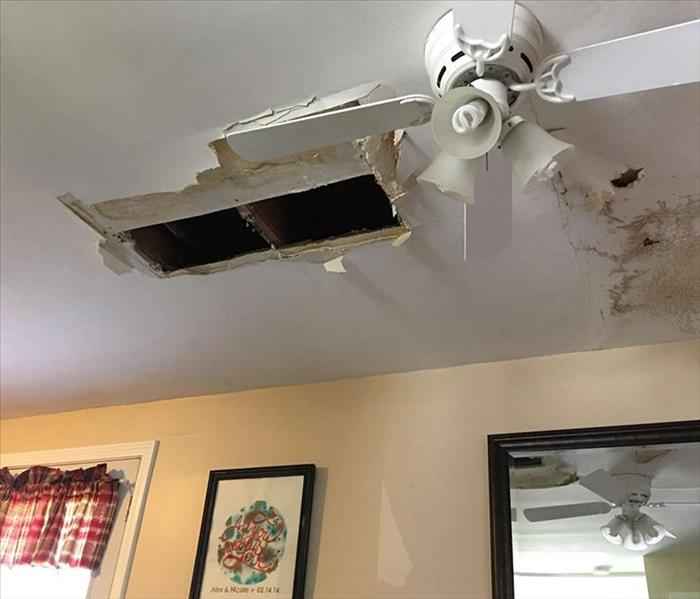 Storm Damage Repair in Centerbrook, CT
Storm Damage Repair in Centerbrook, CT
Storms and inclement weather can bring wind damage, heavy rain, and flooding that can devastate any business in a matter of minutes. There’s never a convenient time for flooding or water damage to strike, and storms don’t just strike during regular business hours; that’s why SERVPRO of Old Saybrook, CT offers 24 hour emergency service 365 days per year because we know that every hour you spend cleaning up is an hour of lost revenue and productivity. So when an emergency situation arises in your Centerbrook property, give us a call and we’ll be there fast with the help you need.
The SERVPRO Commercial Large Loss Division is composed of our best of the best in restoration. Our elite large-loss specialists are prequalified and strategically positioned to handle any size disaster in Centerbrook CT.
Also, the SERVPRO of Old Saybrook Disaster Recovery Team can provide help whether you're dealing with a tornado, hurricane, blizzard or flood. The SERVPRO System has a network of strategically positioned storm teams on standby should a disaster strike near you. Available 24 hours a day and 365 days a year, SERVPRO professionals are prepared for the unpredictable.
At SERVPRO of Old Saybrook, the difference is our ability to dispatch trained production professionals and cut costs through the strategic placement and highly trained crews. Get the professionals, call SERVPRO of Old Saybrook, CT.
Storm Damage Restoration in Old Saybrook, CT
5/25/2017 (Permalink)
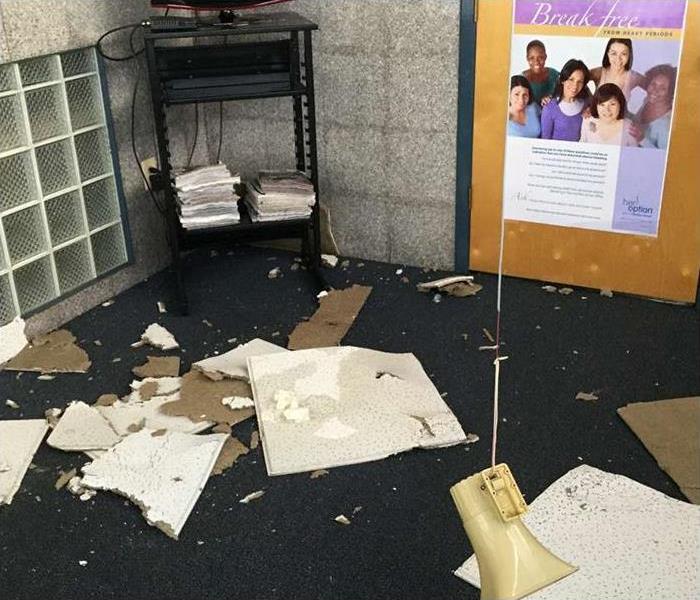 Storm Damage Restoration in Old Saybrook, CT
Storm Damage Restoration in Old Saybrook, CT
Storms and inclement weather can bring wind damage, heavy rain, and flooding that can devastate any business in a matter of minutes. There’s never a convenient time for flooding or water damage to strike, and storms don’t just strike during regular business hours; that’s why SERVPRO of Old Saybrook, CT offers 24 hour emergency service 365 days per year because we know that every hour you spend cleaning up is an hour of lost revenue and productivity. So when an emergency situation arises in your business, give us a call and we’ll be there fast with the help you need.
The SERVPRO Commercial Large Loss Division is composed of our best of the best in restoration. Our elite large-loss specialists are prequalified and strategically positioned to handle any size disaster.
Also, the SERVPRO Disaster Recovery Team can provide help whether you're dealing with a tornado, hurricane, blizzard or flood. The SERVPRO System has a network of strategically positioned storm teams on standby should a disaster strike near you. Available 24 hours a day and 365 days a year, SERVPRO professionals are prepared for the unpredictable.
At SERVPRO, the difference is our ability to dispatch trained production professionals and cut costs through the strategic placement and highly trained crews. Get the professionals, call SERVPRO of Old Saybrook, CT.
Storm or Flood Damage? Call us today!
Property damage repair & restoration!
5/25/2017 (Permalink)
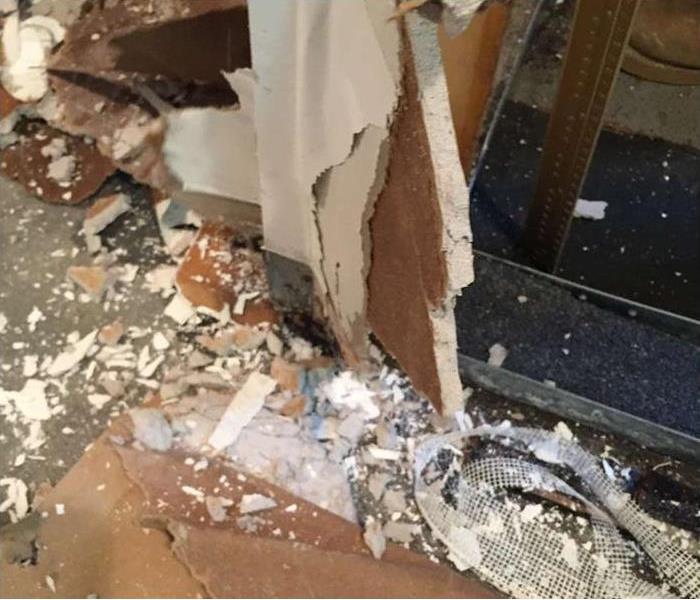 Property damage repair & restoration!
Property damage repair & restoration!
Property damage caused by severe weather can be devastating to your family or business, and repairing it can be a complex undertaking. To get storm damage repair completed quickly and safely, you need a restoration service company that specializes in bringing your home back to its preloss condition.
Learn More About How Storms and Wind Can Damage Your Home
Specialized emergency cleanup and restoration services bring your property back to normal with minimal interruption handling any damage due to severe weather, including:
- Thunderstorms
- Lightning strikes
- Hurricanes
- Tornadoes and high winds
- Hail and ice storms
- Freezing weather and ice dams
From tarping your roof to water removal and structural drying, SERVPRO of Meriden can help you.
Cleanup & Repair:
Whatever wind damage you have experienced, we are fully equipped to help. Contact us for:
- 24/7 emergency services
- Storm damage assessment
- Water damage repair
- Wind damage repair
- Emergency board up
- Tree Removal
- Structural stabilization
- Reconstruction services
- Insurance claim assistance
If your property has experienced damage from a storm, call the experts. We work with a variety of home insurers and can help you determine whether your damage is covered. We can also help with filing paperwork to keep your costs down. Don’t let a storm damage your property value! Contact SERVPRO of Old Saybrook, CT!
What is Storm Surge?
5/5/2017 (Permalink)
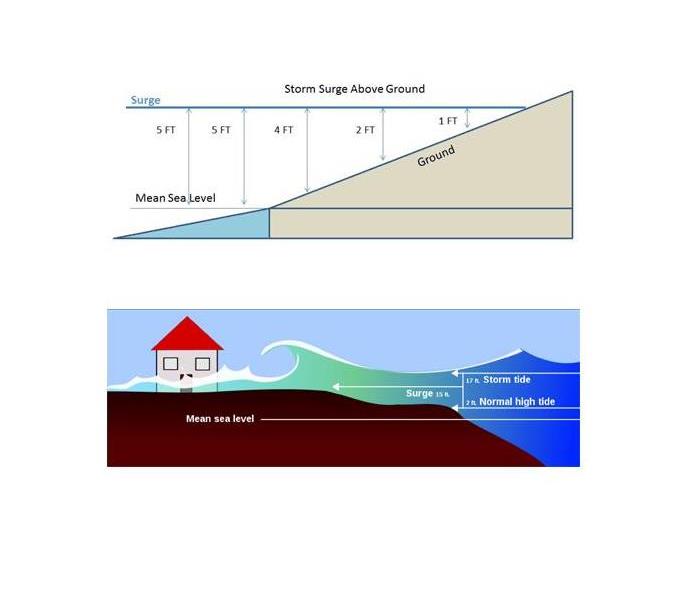 Storm Surge-SERVPRO Of Old Saybrook CT
Storm Surge-SERVPRO Of Old Saybrook CT
Storm Surge
Along the coast, storm surge is often the greatest threat to life and property from a tropical or extratropical storm. (A tropical storm forms over warm waters and is driven by heat transfer from the higher temperatures of the ocean to the lower temperatures at higher altitudes. Extratropical storms result from the temperature contrast between warm and cold air masses as they move against each other horizontally. Tropical storms can become extratropical if they lose tropical characteristics.)
Floods are frequent, costly, and deadly hazards for coastal communities. To prevent disaster, avoid the water and waves; when local authorities instruct you to evacuate, do it quickly!
Storm surge is an abnormal rise in water level, over and above the regular astronomical tide, caused by forces generated from a severe storm's wind, waves, and low atmospheric pressure. Storm surges are extremely dangerous, because they are capable of flooding large coastal areas.
Depth of a Storm Surge
In order to clearly describe flood impacts, storm surge inundation is described in terms of height above ground level. National Weather Service (NWS) storm surge forecasts and statements reference storm surge in this way. This means when NWS forecasts storm surge of 20 feet above ground level for a particular area, 20 feet of water will cover that area. The depth of the flooding above ground level will gradually decrease as it moves further inland. However, some coastal regions have vast areas of low-lying land, so know your local conditions and how far inland local authorities consider vulnerable. Pay attention to evacuation warnings to avoid severe damage.
Need Storm or Flood Cleanup Services?
Call Us Today (860) 249-8685
Source :
https://wikipedia.org/
http://www.nhc.noaa.gov/
 When ice dams cause snow and ice to leak in to your home, immediate action is needed to prevent water damage and mold growth.
When ice dams cause snow and ice to leak in to your home, immediate action is needed to prevent water damage and mold growth.






 24/7 Emergency Service
24/7 Emergency Service





















